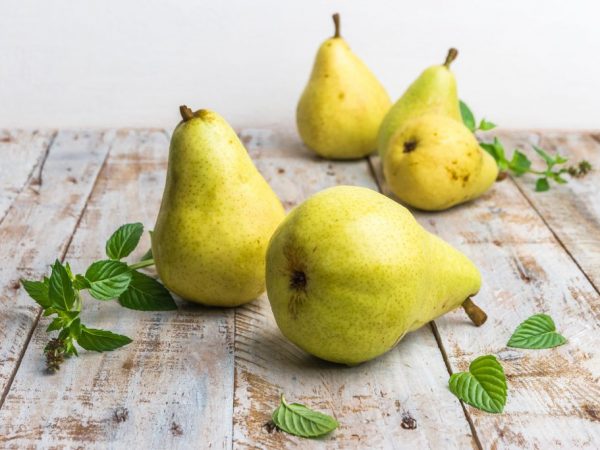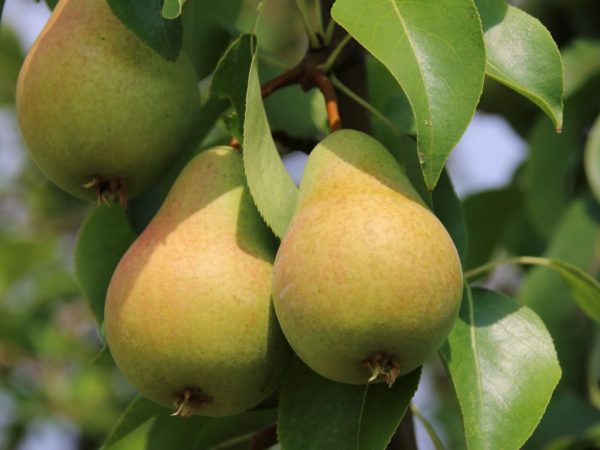Characteristics of Dulia pears
The Dulia pear variety is one of the most common types of this fruit. Dula pear gained popularity due to its high yield and winter hardiness.

Characteristics of Dulia pears
Characteristic
This pear variety can withstand both cold cyclones and hot days. The tree is very fertile. The variety is early maturing. Crop maintenance is minimal. The fruit is a dessert fruit, but it is also well suited for processing.
Description of the tree
The Dul pear tree is most often very tall, its growth can reach 6.5 m. The leafiness is medium. The crown is vertical-oval, which is quite rare. Shoots are of medium length, but rather thick, buds are large and without pubescence.
Description of fruits
Fruit weight 130 g. The color is most often yellow and with a pale pink blush. The fruit has an annual yield, the fruits can be harvested at the end of September, there are a lot of fruits. Harvesting is about 70 kg, and they can be stored for 30 days. The flesh was sweet, coarse-grained, of medium juiciness.
Growing
Growing this fruit will not be difficult. The culture is not capricious, but it has its own characteristics, for example, it is very light-requiring. Difficulties can arise during long foggy days, so it should be planted in the most illuminated areas of the land.
Landing in the soil
The optimal planting time is autumn (early October) or spring (late April). The lip of the pit for planting should be at least 1 m long and 60-80 cm wide. At the bottom, you should definitely put a layer of clay, about 10 cm. The seedling is chosen 1 or 2 years old, before planting, the central root is cut off by 10 cm, the leaves are cut off. After planting the seedling in the soil, you need to tamp it with your hands and mulch.
Plant care
In early spring, before the buds awaken, a young seedling needs to be pruned. It is needed to strengthen the fruitful branches. Semi-skeletal branches are usually cut off. The soil must be kept clean, weeds must be removed. During frosts, the tree needs winter shelter. Having previously treated the trunk with a drug against mice, it is wrapped in burlap, and straw can be used instead of insulation. The end of the insulation is buried.

Seedlings require pruning
Watering in the first year of planting is carried out once a week, over time, when the tree grows, its watering is reduced and carried out 1-2 times a month. You don't need a lot of water, 1-2 buckets will be enough. After watering, the soil must be mulched and loosened.
Fertilizer
Before planting, you need to add organic mineral fertilizers to the soil. Then, in the first 2-4 years of the tree's life, nitrogen fertilizing is applied annually. Further, they will be needed only with explicit nitrogen starvation. Starting from the 5th year of the life of the fruit, the soil needs micronutrient fertilization with minerals every year. During the flowering period, the mule needs additional fertilizing, which increases the quality of the fruit. It can be green fertilizers or top dressing with nitroammophos.During the fruiting period, the plant is fertilized with substances rich in phosphorus and potassium, which will ensure the rapid growth of fruits. Top dressing during this period can be made both root and foliar.
Watering pears
The frequency of watering is influenced by climate and weather conditions. For example, if the days are hot and the ground is dry at the same time, then watering a young tree should be more than 1 time per week. When the tree is already bearing fruit, watering is carried out before and after flowering. Sprinkling is recommended. You can also dig small grooves around the plant and pour water there. Moisture should penetrate approximately 80 cm into the ground. High-quality watering will ensure a large yield and excellent plant growth.
Diseases and pests
Diseases overwhelm the pear quite often. Description of symptoms for possible diseases:
- leaves are brown;
- spots on leaves and fruits;
- dark green spots appear on the leaves on the back;
- the leaves turn yellow and fall off prematurely.
All of these symptoms can be caused by diseases such as:
- brown spotting;
- gray rot;
- scab.
The main pest for Dooley is the pear mite, but aphids, leaf flies, berry bug, weevil, sawfly can also start on it.
Fight disease
If the fruit is sick with brown spot, then in the spring, before its flowering and immediately after it, spray the pear with a Bordeaux mixture of 1% and remove all fallen leaves.
In the fight against gray rot, spray the tree with Skor or Raek preparations, collecting and discarding all damaged fruits.
In the fight against scab, it is also necessary to collect and remove all affected leaves and sprinkle the plant with HOM preparations, Bordeaux mixture, Abiga-Peak.
Pest control
For pest control, the preparation Tanker is most often used (for 10 liters of water, 3 g of the preparation). Kemifos, karbofos, Inta-vir, actellik, fufanon are also suitable.
Prophylaxis
In order to protect the plant from disease or pests, there are several drugs for prevention. For example, phytoverim, rayok, tanker, entobacterion. All the carrion must be collected and burned. During flowering, chemical treatments of the tree are stopped.
Conclusion
Dulia is an excellent choice for growing in your garden. The tree is not capricious, it is not difficult to fight diseases or pests.


